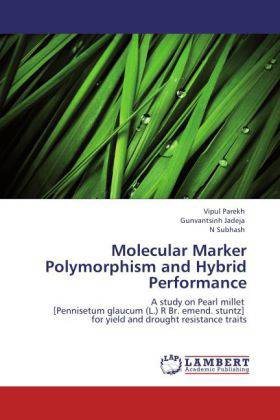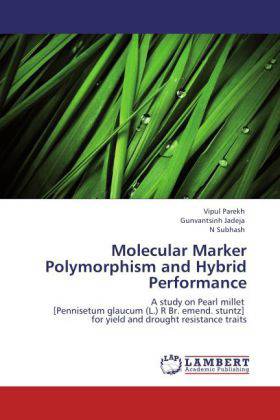
- Afhalen na 1 uur in een winkel met voorraad
- Gratis thuislevering in België vanaf € 30
- Ruim aanbod met 7 miljoen producten
- Afhalen na 1 uur in een winkel met voorraad
- Gratis thuislevering in België vanaf € 30
- Ruim aanbod met 7 miljoen producten
Zoeken
Molecular Marker Polymorphism and Hybrid Performance
A study on Pearl millet [Pennisetum glaucum (L.) R Br. emend. stuntz] for yield and drought resistance traits
Vipul Parekh, Gunvantsinh Jadeja, N Subhash
Paperback | Engels
€ 77,95
+ 155 punten
Omschrijving
Traditionally, the prediction of hybrid performance made on the basis of the morphological traits requires large number of crosses to be made, which have several associated problems. This is where molecular markers will be handy in determining genetic diversity and this will help in predicting hybrid performance. An essential assumption underlying the use of DNA markers for predicting hybrid performance is that a strong linear correlation exists between heterozygosity and heterosis (Singh et al., 2006). Hence, the investigation of correlation existed between "Molecular marker polymorphism and hybrid performance" was undertaken in terminal water stress condition in pearl millet for yield and drought resistance traits.We have tried to investigate the above assumption by using molecular markers (RAPD & SSR) diversion and morphological diversion (Mahalanobis's D2 clustering ) and its correlation with heterosis (MPH, BPH) in pearl millet. Detail results are presented and discussed here in this book, provides insight about the correlation existed between diversity and heterosis in pearl millet.
Specificaties
Betrokkenen
- Auteur(s):
- Uitgeverij:
Inhoud
- Aantal bladzijden:
- 216
- Taal:
- Engels
Eigenschappen
- Productcode (EAN):
- 9783847316183
- Verschijningsdatum:
- 22/12/2011
- Uitvoering:
- Paperback
- Formaat:
- Trade paperback (VS)
- Afmetingen:
- 152 mm x 229 mm
- Gewicht:
- 322 g

Alleen bij Standaard Boekhandel
+ 155 punten op je klantenkaart van Standaard Boekhandel
Beoordelingen
We publiceren alleen reviews die voldoen aan de voorwaarden voor reviews. Bekijk onze voorwaarden voor reviews.











